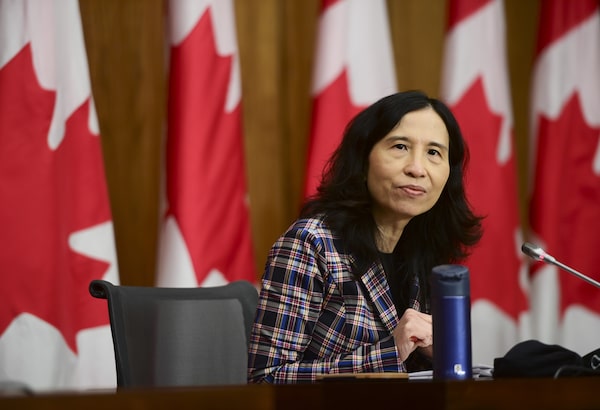
Chief Public Health Officer Dr. Theresa Tam provides an update on the COVID-19 pandemic during a press conference in Ottawa, November 2020.Sean Kilpatrick/The Canadian Press
Canada is in a race against the clock to vaccinate enough people to avoid the worst-case scenarios of a fourth wave of the coronavirus pandemic, driven by the highly contagious Delta variant.
Chief Public Health Officer Theresa Tam and her deputy Howard Njoo presented the monthly modelling update at a news conference on Friday, showing an uptick in COVID-19 cases. They outlined the potential for numbers to surge in the next month past those seen in the last wave of the pandemic, even if vaccinations increase. However, they said the increase may not lead to a comparable surge in hospitalizations and deaths.
“I think we are in a slightly precarious period at the moment in between these people trying to get the vaccines in and reopening,” Dr. Tam said.
The five-week countdown to Labour Day is the key focus for the government’s vaccination push, she said. The modelling from the Public Health Agency of Canada says more than 80 per cent of eligible people need to be fully vaccinated to avoid overwhelming hospitals in the case of a fourth wave. According to COVID-19 Tracker Canada, 81 per cent of eligible Canadians have received their first shot and 66 per cent are fully vaccinated. Health Canada has approved vaccines for people 12 and over.
The unofficial end of summer in Canada is also when colder weather and a return to classrooms will start driving more people inside. “This time is crucial for building up protection before we gather in schools, colleges, university and workplaces,” she said.
Some infectious disease specialists have said Canada should aim for at least a 90 per cent vaccination rate for eligible people in order to limit the impact of the fourth wave. Dr. Tam said her agency put the focus on protecting hospitals, but added vaccination shouldn’t stop at 80 per cent coverage.
“If we can get to 90, I’ll be popping open the champagne,” Dr. Tam said.
Getting to that level is no easy task and will require much more targeted outreach, said Noni MacDonald, a professor of pediatric infectious diseases at Dalhousie University and Halifax’s IWK Health Centre. Dr. MacDonald, who researches vaccine safety and hesitancy, said Canada has come close to but never fully hit the targets for other vaccines, but noted the context for COVID-19 is different because of how front-and-centre the disease is in daily life.
About 5 per cent of adults are hardliners who won’t get the vaccine, Dr. MacDonald said, but there is a “movable middle” group of people – including those looking for more information and others who face barriers owing to a disability, lack of trust in the the system, geographic challenges, irregular work schedules and even needle phobias. All those issues can be addressed, she said, pointing to B.C.’s effort to send mobile vaccination clinics to where people already are – namely beaches and summer camps.
“Barriers of access is a big deal ... you’ve got to actively think about those barriers, and how as a health care program you can overcome them,” Dr. MacDonald said.
To reach higher vaccination levels, peer groups and neighbours can also play an important role in normalizing vaccinations and helping others access the shot, she added.
The Friday modelling also showed that even with 85 per cent full vaccination coverage, cases could surge to about 7,500 a day by the start of September if individual contacts increase by 25 per cent. If the number of people we come in contact with stays unchanged, the modelling predicts about 1,300 daily new cases by September. The trajectory will depend on how high Canada can push its vaccination coverage and “the timing, pace and extent of reopening,” Dr. Tam said.
Of the provinces, Alberta is taking the most aggressive approach to reopening, already ending the majority of its COVID-19 health measures and no longer requiring masks indoors. It will soon lift the self-isolation mandate and stop widespread testing and contact tracing. On Friday, Ontario said once it has met its remaining vaccination targets, it will end the vast majority of public-health measures, including capacity limits at events. However, it will still require masks indoors.
When asked about Alberta’s decision, Dr. Tam said she firmly believes in isolating cases and that the province’s decision puts more onus on individuals.
In June, the public-health agency’s modelling said Canada needed to hit 83 per cent full vaccination coverage to avoid overwhelming hospitals. On Friday, Dr. Tam didn’t explain why that figure was removed from the latest update. She said it was a “very granular number,” but added she does expect that Canada’s vaccination coverage will pass 83 per cent.
Younger people have had less time to book vaccine appointments than older populations who are more vulnerable to COVID-19 and were prioritized earlier in provincial and territorial vaccination campaigns. The Friday modelling underscored the need for many more 18-to-39-year-olds to get their jabs to protect hospitals in the next wave of the pandemic.
If only 72 per cent of that age group are fully vaccinated, then hospitals could again be overwhelmed. According to the models, that risk is greatly reduced if full vaccination coverage in that age group hits 80 per cent.
Know what is happening in the halls of power with the day’s top political headlines and commentary as selected by Globe editors (subscribers only). Sign up today.
 Marieke Walsh
Marieke Walsh